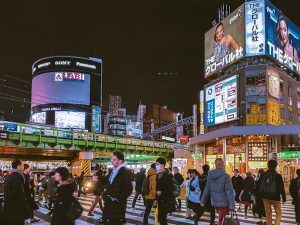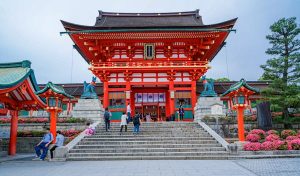
“Vibrant” aptly characterizes Tokyo. With a genuine passion for anime, Japan’s sprawling metropolis pulsates with ceaseless activity—yet amidst the dazzling lights and loud signs, there’s an invitation to pause, to momentarily halt in the whirlwind of consumerism. Tokyo thrives on movement and advancement, a city in perpetual motion. So, what’s keeping you? It’s time to dive into the vibrant pulse of Japan with these Tokyo Travel Tips.
Tokyo Travel Tips: The Vibrant Pulse of Japan in 2024!
The tech-savvy locals traverse monuments and urban parks daily (save for the cherry blossom season when crowds flock to green spaces), and the city boasts world-class museums and historical landmarks. There are sights to capture, sushi to savour, and endless shopping opportunities awaiting.
The Optimal Times to Visit
The optimal times to visit Tokyo are from March to April and September to November. During autumn, you’ll be greeted with vibrant foliage and pleasant temperatures. Spring, conversely, offers the enchanting spectacle of cherry blossom trees in full bloom, marking the peak tourist season. While summer can be uncomfortably hot, it’s less crowded than spring, although June and July may bring frequent rainy days. Winter sees chilly temperatures, with highs in the 50s and 60s and lows in the mid-30s, limiting outdoor park experiences.
Tips for Saving Money in Tokyo:
Explore Free Attractions:
Take advantage of Tokyo’s numerous free attractions, including Tsukiji Outer Market, Meiji Shrine, Imperial Palace Grounds and East Garden, Senso-ji Temple, and the Tokyo Metropolitan Government Building. Additionally, Tokyo boasts many must-visit neighbourhoods and parks that won’t cost you a yen.
Opt for Vintage Finds:
Embrace Tokyo’s vibrant fashion scene by shopping for vintage apparel, which often finds its way to thrift stores after just a month in stores. Tokyo’s fashion trends change rapidly, so going vintage can give you a classic look in Japan and keep you on the cutting edge back home.
Indulge in Japanese Cuisine:
Skip pricey Western-style restaurants and dive into the world of Japanese cuisine. Explore local eateries to enjoy meticulously prepared dishes like sashimi, tempura, kare raisu (curry rice), and ramen, which offer delicious flavours and fit within your budget.
Culture & Etiquette:
Tokyo’s culture embodies a fascinating juxtaposition of tradition and modernity, where ancient temples coexist with futuristic skyscrapers. While the city pulsates with consumerism, its inhabitants follow a stringent code of behaviour, even in personal settings. Though the customs may seem overwhelming, as a Western visitor, you’re not expected to be fluent in them. A slight tilt of the head serves as a sufficient greeting, and if offered a handshake by a Japanese person, it indicates you need not bow.
In Tokyo, the predominant language spoken is Japanese, though many residents, particularly in tourist-centric areas, have some proficiency in English. Learning basic phrases like “sumimasen” (excuse me/sorry) and “arigato” (thank you) can significantly enhance communication. Moreover, taking off your shoes is customary upon entering a Japanese home or traditional establishment.
Currency & Tipping:
The Japanese yen is the standard currency used in Tokyo.
Although major credit cards are broadly acknowledged, carrying some cash for transactions is advisable, particularly in smaller establishments. Tipping is rare in Japan and may even be refused if attempted.
Dining Etiquette:
Avoid eating or drinking while on the move when dining in Tokyo, as it’s considered impolite. Be mindful of chopstick etiquette, ensuring they are not left standing upright in food and refrain from playing with them. Blowing your nose in public is also discouraged; if necessary, find a private area. These cultural nuances contribute to the respectful and harmonious atmosphere of Japanese society.
What to Indulge In:
Tokyo’s culinary landscape is a testament to its status as a gastronomic paradise, boasting over 160,000 restaurants and the highest number of Michelin-starred establishments globally. Yet, it’s not just the sheer quantity that sets Tokyo apart; the unparalleled quality of locally sourced ingredients, lenient import regulations, and unwavering commitment to culinary heritage elevate its dining scene to legendary status.
One distinguishing feature is the prevalence of shokunin—masters who dedicate their lives to perfecting a single dish. From savoury ramen to crispy tempura and succulent yakitori, these artisans craft culinary wonders tantalizing the taste buds. Don’t miss out on sekitori—charcoal-grilled chicken skewers—or the exquisite flavours of unagi, meticulously prepared and grilled to perfection.
For a more refined experience, savour kaiseki—a meticulously curated multi-course feast showcasing seasonal delicacies. Wash it all down with a refreshing Japanese beer from renowned brewers like Asahi, Kirin, and Sapporo. And for a sweet finale, indulge in anything matcha-flavored. For an authentic Tokyo culinary adventure, seek out micro-restaurants with intimate settings boasting only a few seats for an exclusive dining experience.
Safety Precautions:
Tokyo’s reputation as a safe city holds, boasting low crime rates and minimal incidents of pickpocketing compared to other major urban centres. Japan itself is renowned as one of the safest countries globally. Nonetheless, exercising caution, especially during nightlife escapades, is advisable.
While areas like Shinjuku, particularly the Kabukicho red-light district, have encountered instances of illicit activities and crime, other neighbourhoods like Roppongi and Ikebukuro have also reported incidents of theft and assault, particularly in expatriate communities. Even in safer districts, it’s wise to remain vigilant when out and about after dark. For additional guidance, refer to the State Department’s official website.
Navigating Tokyo:
The subway reigns supreme as the optimal mode of transportation within Tokyo, boasting an extensive and efficient network that swiftly connects every corner of the city. This subway system also provides direct links to Narita International Airport (NRT) and Haneda Airport (HND), facilitating seamless travel to and from the city’s major airports.
While the bus system is equally extensive, it often needs more traffic delays and may bewilder non-Japanese-speaking travellers. Although Tokyo’s sprawling expanse makes walking impractical for covering long distances, strolls through its vibrant neighbourhoods offer a firsthand glimpse into the city’s dynamic atmosphere.
While taxis can be pricey, they become indispensable during late-night or early-morning hours when the subway is not operational. For a convenient alternative, ride-hailing apps like Uber provide hassle-free transportation solutions amidst Tokyo’s bustling streets.

Entry and Exit Guidelines:
When travelling to Japan, ensure you possess a valid U.S. passport for entry. Under visa-free provisions, you may stay for up to 90 days. For comprehensive details, consult the U.S. Department of State’s official website.
Essential Things to Do:
Explore Tokyo’s dynamic rhythm with over 13 million inhabitants buzzing around. Kick off your day with breakfast sushi at the renowned Tsukiji Outer Market, then delve into Japan’s rich history at the Tokyo National Museum. Spend an hour or two unwinding in the lush surroundings of the Imperial Palace or Shinjuku Gyoen National Garden. Dive into Tokyo’s colossal shopping scene at Ginza, waterfront Odaiba, or the tech paradise of Akihabara. For eclectic finds, Shimokitazawa in west Tokyo offers enticing thrift shopping experiences.
Experience the electrifying energy of Shibuya Crossing, the world’s most prominent intersection, where go-karting tours zip through the crowds. Seek a local vibe in Daikanyama’s tree-lined streets, where brunch spots and the T-Site mega-bookstore await.
Cap off your day with a breathtaking ascent to the sky at Tokyo Tower or the Tokyo Metropolitan Government Building, offering panoramic city vistas. Alternatively, secure a spot at Park Hyatt’s New York Bar for an unforgettable evening of jazz against the city’s glittering backdrop. Finally, immerse yourself in Tokyo’s heritage with visits to iconic landmarks like Senso-ji Temple and the serene Meiji Shrine.
Top 3 Best Places to Visit in Tokyo, Japan:
Shinjuku Gyoen National Garden
Situated just west of downtown Tokyo, Shinjuku Gyoen National Garden emerges as a captivating urban retreat spanning 144 acres. Remarkably, it integrates three distinct landscaping styles – Japanese traditional, French formal, and English garden – offering a diverse and picturesque ambience. During spring, the garden becomes a magnet for visitors drawn to its stunning cherry blossom spectacle.
To fully immerse in this seasonal delight, follow the locals’ lead and pack a picnic basket for a delightful outdoor experience. Autumn also beckons travellers with its kaleidoscope of vibrant foliage, peaking from mid-November to mid-December.
Shinjuku Gyoen National Garden earns accolades from travellers as an idyllic escape from Tokyo’s frenetic pace. Visitors say even a brief stroll through the park absorbs its serene atmosphere. Moreover, amenities abound within the garden, including restroom facilities, dining options, a greenhouse, and a charming teahouse, ensuring a delightful and rejuvenating visit.
Senso-ji Temple
Tokyo’s Senso-ji Temple is the city’s oldest and most frequented religious site, drawing approximately 30 million visitors annually to its hallowed grounds. Dating back to 628, this venerable temple has undergone numerous rebuilds, most notably after its near-total destruction during World War II. Devoted to Asakusa Kannon, the Buddhist deity of compassion and joy, Senso-ji holds legendary origins, with tales of fishermen discovering a golden statue of the god in the Sumida River.
Though the revered statue remains off public display, devotees and curious tourists flock to the shrine, seeking the healing blessings attributed to Kannon. Upon touring the temple, visitors often explore Nakamise Dori’s vibrant shops en route, completing their cultural immersion.
Many travellers cherish their time at Senso-ji Temple, considering it an essential Tokyo experience. Admiring its majestic architecture and ornate details, visitors praise the temple’s beauty. However, some express frustration with the crowds that throng the attraction, making peaceful contemplation difficult. To avoid the masses, seasoned visitors seeking a quieter temple encounter recommend early morning or late-night visits.

Meiji Shrine
The Meiji Shrine, a revered Shinto sanctuary, honours Emperor and Empress Shoken. It is credited with modernizing Japan by integrating Western ideals into its society, including adopting a cabinet system.
Established after the monarch’s passing in 1912 and his consort’s in 1914, the shrine commemorates their contributions. Beyond its architectural splendour, the shrine’s lush surroundings, forming part of the expansive Yoyogi Park, captivate visitors. Donated by Japanese citizens nationwide as a token of gratitude to the emperor, the forest boasts over 100,000 trees.
While visiting this sacred locale, partake in traditional rituals. Upon entering, observe the Torii, a grand archway marking the shrine’s threshold, bowing respectfully upon passage. At the Temizusha, a purification station resembling a drinking fountain, cleanse yourself with holy water by washing your hands and rinsing your mouth but refrain from drinking.
When approaching the main shrine, pay homage with two bows, followed by two claps and another bow. Though observing these customs is voluntary, adhering to shrine etiquette is imperative: refrain from photographing the interior, eating, drinking, or smoking outside designated areas.
Conclusion:
Tokyo’s vibrancy is undeniable, fueled by its fervent embrace of anime culture and relentless urban energy. Amidst the hustle and bustle, there’s an intriguing juxtaposition—a call to pause amidst the frenzy, to savour moments amidst the whirlwind of consumerism. Tokyo embodies perpetual motion, a city that thrives on its constant evolution. So, why hesitate? Embrace the vibrant pulse of Japan and embark on an unforgettable journey through Tokyo with these essential travel tips.


